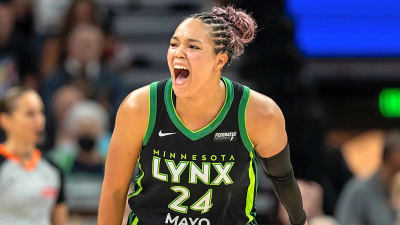
The New York Jets may be 0-4, but if you live on the optimistic end of the fandom spectrum, you don’t have to dig far beneath the surface to find silver linings.
Three of the Jets’ four losses were by one score. Across those three games, the Jets lost by a combined total of only 10 points. They also outgained their opponents by more than 100 yards (1,065 to 918) and picked up 10 more first downs (67 to 57).
It is easy to paint a picture of the Jets being just a handful of plays away from a 3-1 start. Take away Xavier Gipson’s fumble, wipe away Tyrod Taylor’s pick-six, and add a Garrett Wilson touchdown that shouldn’t have been overturned by a phantom penalty, and boom! You have a 3-1 New York Jets team in Aaron Glenn’s first season as a head coach.
Are the Jets really that close to being a competitive football team? Or are they exactly who their 0-4 record says they are?
Judging the true quality of an NFL team is always a complex challenge. By nature, football is a fluky sport. It differs from other sports in that the final score is often an inaccurate reflection of how “well” both teams truly performed on a play-to-play basis.
This is because extremely consequential events can happen at any moment, overriding whatever happened previously. An outstanding 12-play drive can be rendered meaningless by a fumble inches away from the goal line. A blocked field goal returned for a touchdown represents a 10-point turnaround that flips an entire game on its head.
Additionally, many of these consequential events happen due to total randomness, such as the bounce of an oddly shaped ball, the judgment of officials who are highly prone to mistakes, or the opponent’s proneness to unforced errors. The sport’s unique randomness takes even more control out of a team’s hands.
All of these factors make evaluating football much different from sports like basketball and baseball, where the final score is essentially a direct reflection of how “well” each team played. Ultimately, if you aren’t putting the ball in the hoop or getting runners across home plate, you aren’t playing well. But in football, you can do plenty of positive things to maximize your chances of winning, only for those efforts to be squandered by a handful of costly errors.
And with only 17 games in a season, a couple of those costly errors can be the difference between a miserable 7-win season that often lands you a top 10 draft pick and a 9-win season that is enough to sneak into the playoffs. There aren’t enough games for luck to normalize, allowing us to see teams for who they really are.
Over 162 MLB games or 82 NBA games, a team’s record probably tells us precisely who they are. Perhaps we can give or take a few games based on different variables, like a team’s close-game record or how they performed with or without certain players who missed time, but the massive sample size helps to even out luck-based factors.
NFL teams don’t have the luxury to chalk up a game or two to bad luck and expect people to forgive them. Within a 17-game schedule, two games represent a massive difference in a team’s reputation. If the Jets were 2-2 right now, fans would be on cloud nine about the franchise’s outlook. Instead, with just two fewer wins, they are a winless, directionless organization that should be banished from the NFL and forced to rebrand as a traveling circus.
In the average NBA game, each team gets over 100 possessions. That is a large enough sample for luck-based factors to normalize over the course of the game. Generally speaking, the “better team” should win most basketball games.
Compare that to football, where the average team in 2025 gets only 10.5 possessions per game. It offers a substantially higher likelihood that a game can come down to the outcome of any one possession, even if it’s the first drive of the game.
READ MORE: Justin Fields is only getting worse in a critical areaFurthermore, football offers a unique scoring system that is much less incremental than sports like basketball and baseball. It allows for jarring shifts on the scoreboard that are not reflective of what led up to those points being scored.
Basketball teams gradually accumulate tiny bits of points across many possessions. Save for the final few possessions, there can never be those one or two highly consequential plays that completely shift the momentum of a game. Baseball offers more chances for high-leverage moments, but teams can chip away with one run at a time over nine innings.
In football, the general game flow revolves around taking dozens of plays to set yourself up for one giant score. You kick the ball off, stop the return at the 20-yard line, stop the opponent’s drive after five plays, force a punt, get a nice punt return, and drive 10 plays to the one-yard line. Everything is going perfectly. You’re dominating.
But the scoreboard still says 0-0.
Then… bang – with one lost fumble at the goal line by your running back, returned for a 99-yard touchdown by the opponent, you are now down 7-0 because of one player’s individual mistake, even though you have been outplaying the opponent on just about every play.
There isn’t another sport where that type of phenomenon can happen.
It’s why evaluating a football team has to go deeper than simply their win-loss record.
All of that brings us back to the 0-4 New York Jets. Who are they?
Let’s peel back the layers of New York’s first four games to understand how “well” this team has actually played, and what it means about their potential to win games going forward.
Total yards and first downs
One way to account for the luck-based elements of football is to view the season as one giant game. If we want to predict how a team might perform in its next game, it makes sense to look at their season-long performance in totality.
It is especially important to evaluate larger-sample metrics related to moving the football, like total yards, first downs, and other things of that variety that accumulate into fairly reliable samples over the course of the season. These offer a more predictive evaluation of how well a team might position itself to score and prevent touchdowns in the future.
While things like turnovers, penalties, and special teams plays can be critical in any one game, they tend to be less predictable from week to week. Thus, your best bet at evaluating an NFL team is often to look at its overall performance in more sustainable metrics.
Through that lens, the Jets look much better than an 0-4 team. It’s not to say that they are secretly a juggernaut, but they don’t look helpless.
The Jets are 21st in total offense (1,219) and 20th in total defense (1,321). Their total yardage margin of -102 ranks 22nd in the NFL.
That is nothing groundbreaking by any stretch of the imagination, but it’s better than about a third of the league.
When it comes to total first downs, the Jets are tied for 13th with 78 offensively, while they rank 23rd with 82 allowed defensively. Their total first down margin of -4 ranks 21st.
With rankings of 22nd in total yardage margin and 21st in first down margin, New York has not been far off from a league-average team in terms of down-to-down ball movement.
So, how are they 0-4?
That’s easy: The Jets are falling well short in the “swing factors.”
Swing factors
Categories like total yards and total first downs form the backbone of an NFL game. Those are the areas where teams shift the odds in their favor as best as they can before the game is tilted by the swing factors: a small collection of plays that each make a massive impact on the scoreboard. This includes facets like turnovers, the red zone, critical penalties, and special teams.
For the Jets, their turnover ratio is the swing factor that has done the most heavy lifting to drag their record beneath what it “should” be.
If there were no such thing as turnovers, it would be fair to say New York is somewhere from the 21st to 22nd-best NFL team based on their rankings in yardage and first downs. But the Jets have fallen well short when it comes to the scoreboard-tilting plays.
The Jets have an NFL-worst turnover margin of -7. They have lost the turnover battle in each of their four games. With three of those losses coming by one score, it is easy to picture any of them being flipped to a win if the turnover margin flipped.
READ MORE: Aaron Glenn’s New York Jets: Playing to make the next mistakeTherein lies the core dilemma of evaluating NFL football. Yards and first downs are accumulated over the 60+ plays that both teams run over the course of the game. They feel like the best measures of how “well” a team is playing. And in these categories, the Jets are not far off from middle-of-the-pack.
Turnovers, on the other hand, represent no more than a handful of plays over the course of the game, yet they can be more impactful collectively than the rest of the game combined. It’s in this category where the Jets have struggled.
Thus, we get the Jets’ 0-4 record with three one-score losses and relatively respectable rankings in overall categories. They may look decent much of the time, but they are getting dominated when it comes to the small percentage of plays that have game-shifting weight.
Turnover luck
While the Jets’ turnover margin is poor, it has to be acknowledged that they have been extremely unlucky in that department.
There have been 14 fumbles in the Jets’ four games this year. New York recovered just two of them. That’s a 14.3% rate, the lowest in the NFL.
While the Jets have yet to record a takeaway, they have forced six opponent fumbles, and yet, none of them ended up in the Jets’ hands. And while the Jets have lost a league-high six fumbles, they have been unfortunate to see 75% of their eight fumbles wind up in the opponents’ grasp.
With 50-50 fumble luck on the same volume of fumbles and fumbles forced, the Jets would currently have four lost fumbles to three recovered fumbles (-1), as opposed to their actual margin of six lost fumbles to no recovered fumbles (-6). That alone would shift the Jets’ overall turnover margin from -7 to -2.
Think about it: Just with 50-50 luck in a category that is supposed to be a sheer coin flip (fumble recoveries are almost entirely up to the luck of the bounce and feature little-to-no controllable skill), the Jets’ turnover margin would improve by five, and that’s over a measly four-game span with three one-score losses.
It is easy to see anywhere from one to three of those losses being flipped if the ball decided to bounce evenly.
In this hypothetical world where the Jets’ fumble luck were average, their turnover margin of -2 would be tied for 21st, the same neighborhood as their rankings in total yardage margin (22nd) and total first down margin (21st).
Despite their record… is this sneakily the 21st or 22nd-best team in the NFL?
Not quite.
Perhaps these metrics indicate that New York has the ceiling of the 21st to 22nd-best team in the NFL, but they aren’t there yet.
We have to knock the Jets for their losing ways until proven otherwise
As easy as it is to chalk the Jets up as a better team than their record, we cannot forget the objective of the sport when it’s all said and done: Winning games.
Ultimately, the standings do not care how you get your wins. You can win 6-0 with -10 yards and three safeties, or you can win by 50 with a +500 total yardage margin. There is only one win up for grabs in each game.
Right now, the Jets have had four attempts to win a football game, and they came up short four times. Until the Jets prove they know how to win, we can only give them so much credit for being “close” or “better than their record.”
Because, at the end of the day, all of these stats are evaluated for one reason: They are supposed to facilitate winning. If those wins aren’t coming, then the stats are empty.
We analyze stats because we want to predict a team’s ability to earn future wins, and these stats are often more predictive than simply looking at a team’s win-loss record. While that thought process is correct, we should never overlook the reality that winning is a skill in itself.
Many franchises have proven they know how to win games on a yearly basis even if their overall metrics do not always paint the picture of a team that should be winning as many games as they do. This knack is what separates perennial winners from the pack.
Look no further than the Pittsburgh Steelers, who have been winning ugly games for years despite subpar quarterback play and ugly offensive statistics. Logic says the Steelers’ luck should have run out long ago, but they keep winning games they “shouldn’t.” At this point, it has to be acknowledged that Pittsburgh’s winning ways under Mike Tomlin are a skill, not a product of sheer luck, unless we’re to believe the statistically improbable.
On the other end of the spectrum, you have franchises like the Jets, who consistently find ways to lose every year despite often having on-paper talent, frequently posting gaudy defensive metrics (more so offensive metrics in the case of this year’s first four games), and seemingly being perpetually due for their luck to normalize.
At some point, you just have to go out there and win some games. However you pull it off, whether it’s through yardage, first downs, turnovers, the red zone, field goals, returns, or some stroke of dumb luck, you need to have more points than the opponent when the clock shows triple zeroes. That is the goal, and the Jets haven’t been able to do it yet under Glenn.
Is that a groundbreaking revelation? Of course not. Admittedly, I feel as if I just wasted your time making you read all of these words just to come to a conclusion that could not be more basic. I can hear the inside of your mind: “Wow, the team with more points wins the game! Riveting! Thank you, Jets X-Factor!”
Perhaps, though, something more profound lies beneath the surface of our elementary conclusion.
Remember when we talked about the complexity of football? How it has a tiny sample of opportunities, a proneness to highly consequential plays, an inherent randomness, and a wonky scoring system?
Well, when you combine those convoluted factors with a basic goal (score more points than your opponent), it shows that winning the scoreboard of a football game is its own art form, one that does not always correlate with any particular metric. There are many ways to do it, and any way is the right way, no matter how lucky, sustainable, or impressive it may or may not be.
Coming back to the Jets, the silver lining is that yes, the team does appear “close.” For the most part, they are not getting blown off the football field. Save for their Week 2 disaster against Buffalo, the Jets can look back at their other three games and picture them as potential victories if they had made just one fewer bone-headed error.
Avoiding those bone-headed errors, though, is an acquired skill – as is forcing the opponent to make them. We can only spend so much time saying the Jets are “due” until it becomes a proven reality that they are flat-out unskilled at winning the swing factors.
The good news for New York is this: Losing games because of a handful of swing plays per game is much more fixable in the short term than making up gaps of multiple touchdowns and hundreds of yards. The fellow 0-4 Tennessee Titans (31st with a -632 total yardage margin) have been overwhelmingly dominated on a down-to-down basis. They are not in a position to win games even if they had exceptional luck, as they have problems that are unfixable until the roster can be strengthened in the offseason.
The Jets, though, aren’t nearly as far off. If they manage to tilt the swing factors back to the median over the next 17 games, they will likely start winning close to half of their games if their overall level of play stays about the same.
Here’s the bad news: Fixing this issue is easier said than done, even if it seems easy because we’re only talking about a handful of plays per game.
If it were easy to win the turnover battle, avoid killer penalties, and execute routine special teams plays, then every team would be doing it on a weekly basis, and win-loss percentages would directly correlate with total yards and total first downs. That’s not the case, though, because winning the swing factors – as small-sample and fluky as they are – is a skill. Good teams master it, bad teams don’t.
How exactly can the Jets master it, though? Especially when their failures so far have largely boiled down to brutal fumble luck?
It doesn’t matter what the answers are. New York just has to find them, because the excuses won’t last forever. One or two close losses can be written off, but at 0-4, the Jets are nothing more than a frisky team that has no idea how to make winning plays, as semi-decent as their overall numbers may be.
Maybe the Jets aren’t forcing the right type of fumbles. Maybe they are too prone to the type of fumbles that are easier to recover. Maybe it really is nothing more than flat-out bad luck, although there is an implied 1-in-154 chance of recovering fewer than three fumbles out of 14 if we assume each one is a 50-50 proposition, so it is wildly unlikely, unless the Jets truly are that unlucky.
Who knows. We can spend all day theorizing why the Jets do not get more fumbles to bounce their way, why they cannot pick off a pass, and why the referees seemingly dislike them.
But until anything actually changes, the only known truth is that the New York Jets are a winless team that has not shown the ability to make winning plays. They are pretty darn good at making games look close, which is a nice silver lining that provides realistic hope of an impending turnaround, but the longer they take to build upon that hope, the more it will appear that the Jets are who they are: a losing team.
More must-reads:
- Latest injury report has Ravens season hanging by thread
- Myles Garrett makes bold claim about Browns QB Dillon Gabriel ahead of first NFL start
- The 'Active multiple 140-receiving-yard games' quiz
Customize Your Newsletter
 +
+
Get the latest news and rumors, customized to your favorite sports and teams. Emailed daily. Always free!








